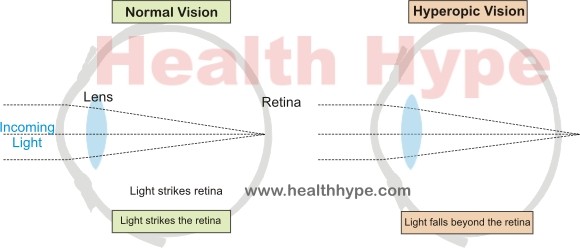Hyperopic Vision (Long Sighted) and Hyperopia with Age
Light entering the eye has to be refracted (bent) so that a sharp image can be focused on the retina of the eye. The retina is the photosensitive inner layer of the eye that converts the light into nerve impulses. Via the optic nerve, these impulses are relayed to the brain and is perceived as the sense of vision. The cornea on the outer part of the eyeball and the lens within the eye are primarily responsible for this refraction of light. Common visual problems in humans are mainly due to refractive errors. This means that the light is refracted in a manner that casts a sharp image short of the retina or just past it. These refractive errors are known as myopia (short sight) or hyperopia (far sight) respectively.
What is hyperopia?
Hyperopia or hypermetropia is the inability to see near objects although far vision may be normal. It is also commonly known as farsightedness or long sight. With minor hyperopia the near vision is not compromised to a significant degree or sometimes not at all. The only symptoms in these cases are eyestrain and headaches and corrective lenses are not needed. With mild and severe hyperopia, the visual difficulty is more pronounced and typical of farsightedness. Corrective lenses, whether eyeglasses or contact lenses, and surgery like LASIK, can correct the refractive error.
How does hyperopia occur?
The lens of the eye is a flexible biconvex structure than can change its curvature at will. Alterations of the curvature bends light to different degrees (refraction) and helps to focus light on the retina. This process is known as accommodation. Light from faraway needs to be bent less while light from nearby object needs to be bent more in order to focus a sharp image on the retina. The lens is held in the eyeball by suspensory ligaments. When the ligaments slacken, the lens becomes rounder. Conversely, when the ligaments tighten the lens becomes flatter. The ciliary muscles of the eye are able to tighten or slacken the suspensory ligaments as is necessary for clear vision.
Normally the ciliary muscles are relaxed and the suspensory muscles tight. This allows for normal vision (emmetropia) where distant objects can be seen clearly. A sharper focus of nearby light, however, requires more bending of the light which can be achieved by making the lens more round through the contraction of the ciliary muscles. In a person with hyperopic vision, the light does not fall on the retina when the ciliary muscles are relaxed. Instead it falls behind the retina. This may be due to a shorter than normal eyeball or refractive errors of the cornea or lens.
Hyperopia with Age
Fortunately the lens can accommodate for this shortfall in refraction that leads to hyperopia. By contraction of the ciliary muscles, the suspensory ligaments slacken slightly and the lens becomes rounder. Light can now be bent more to focus a sharp image on the retina. Since the ciliary muscles are normally relaxed for far vision, in hyperopia these muscles have to work for longer hours – both for far vision and near vision. This leads to strain of the muscle. Over time and depending on the severity of the hyperopia, this accommodation cannot be maintained. The lens can focus the distant light but has no more accommodative power to focus the light for very near object.
With age, the ability to see near objects diminishes irrespective of visual disturbances from earlier in life. This is known as presbyopia. Everybody becomes presbyopic with age, which usually starts after the age of 40 years. A person who is suffering with hyperopia but had the accommodative power to compensate earlier in life will discover this farsightedness later in life. People with myopia (nearsightedness) may find that the corrective measures that were previously useful is now less so. Instead seeing clearly from very close up will require removal of the glasses or contact lens in a person who is myopic.
Causes of Long Sight
The causes of hyperopia is genetic. A shorter eyeball, a flatter cornea, a shorter distance between the cornea and lens or a lens that does not bend light sufficiently lead to long sight. Although it is inherited in most cases, there are some rare causes of hyperopia such as :
- Small eyes (micropthalmia) which can causes a severe hyperopia known as nanopthalmos.
- Diabetes melltius
- Cancer around the eye
- Retinal vascular disease
Signs and Symptoms
The main symptom is difficulty seeing near objects while distant vision is clear. Without corrective lenses a person may need to squint but this may not be sufficient. Sometimes a person with very mild hyperopia does not experience any difference in near or far vision and the other signs and symptoms mentioned below is present. This is more likely to before the age of 40.
Apart from the difference in near and far vision, the presentation of hyperopia is similar to the symptoms of myopia. This includes :
- Aching or burning of the eyes.
- Headaches.



